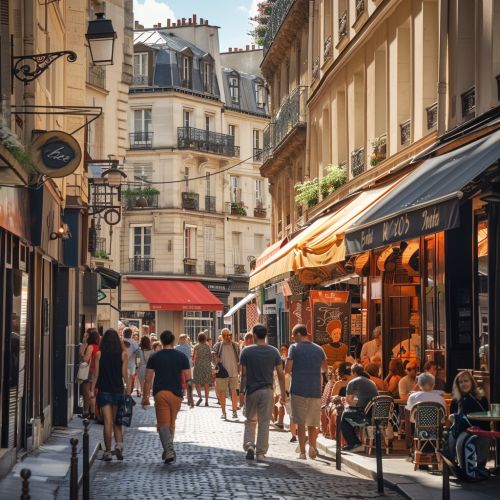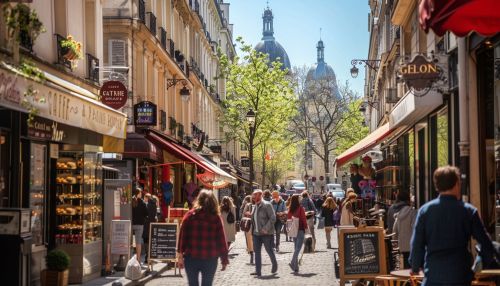Latin Quarter, Paris
History
The Latin Quarter (French: Quartier latin) is one of the most famous and historic districts in Paris, located on the left bank of the Seine River. The area is known for its vibrant student life, bistros, and historic landmarks. The Latin Quarter has been a center of education and intellectual life since the Middle Ages, largely due to the presence of the University of Paris, one of the oldest universities in the world.
Medieval Origins
The Latin Quarter's name derives from the Latin language, which was widely spoken in and around the University of Paris during the Middle Ages. The university was established in the 12th century, and Latin was the lingua franca of scholars and students. The district quickly became a hub for intellectual activity, attracting students from all over Europe.
Renaissance and Enlightenment
During the Renaissance, the Latin Quarter continued to be a center of learning and culture. The Collège de France was founded in 1530, offering lectures in a variety of subjects, including Greek, Hebrew, and mathematics. The Enlightenment further solidified the Latin Quarter's reputation as a center of intellectual and cultural life. Philosophers like Voltaire and Jean-Jacques Rousseau frequented the area, contributing to its rich intellectual heritage.
19th and 20th Centuries
In the 19th century, the Latin Quarter became a focal point for artistic and literary movements. Writers like Victor Hugo and Honoré de Balzac lived and worked in the area. The Sorbonne, the main building of the University of Paris, became a symbol of academic excellence. The 20th century saw the Latin Quarter as a center for political activism, particularly during the student protests of May 1968.
Architecture
The Latin Quarter is renowned for its diverse architectural styles, ranging from medieval buildings to modern structures.
Medieval and Renaissance Architecture
One of the most iconic buildings in the Latin Quarter is the Panthéon, originally built as a church dedicated to St. Genevieve, the patron saint of Paris. The Panthéon exemplifies neoclassical architecture and now serves as a mausoleum for distinguished French citizens. Another notable structure is the Église Saint-Étienne-du-Mont, which combines Gothic and Renaissance architectural elements.
19th and 20th Century Architecture
The 19th century brought Haussmannian architecture to the Latin Quarter, characterized by wide boulevards and uniform building facades. The Boulevard Saint-Michel is a prime example of this style. In the 20th century, modernist architecture made its mark with buildings like the Institut du Monde Arabe, designed by architect Jean Nouvel.


Education
The Latin Quarter is synonymous with education and scholarship, home to some of the most prestigious institutions in France.
University of Paris
The University of Paris, often referred to as the Sorbonne, has been a cornerstone of the Latin Quarter since its founding in the 12th century. The university is divided into several faculties, including humanities, sciences, and law. The Sorbonne's main building is a historic landmark, featuring a grand amphitheater and a library with an extensive collection of rare books and manuscripts.
Collège de France
Founded in 1530, the Collège de France is an institution dedicated to research and higher education. Unlike traditional universities, the Collège de France does not offer degrees but provides free lectures open to the public. The institution has hosted some of the most renowned scholars in various fields, including Claude Lévi-Strauss and Michel Foucault.
Other Institutions
The Latin Quarter is also home to several other educational institutions, such as the École Normale Supérieure, a highly selective higher education establishment, and the Lycée Louis-le-Grand, one of the most prestigious secondary schools in France.
Culture
The Latin Quarter is a cultural hotspot, offering a rich tapestry of museums, theaters, and bookstores.
Museums
The Musée de Cluny, also known as the National Museum of the Middle Ages, is located in a former abbey and houses an extensive collection of medieval artifacts, including the famous Lady and the Unicorn tapestries. Another notable museum is the Musée de l'Institut du Monde Arabe, which showcases the art and culture of the Arab world.
Theaters
The Latin Quarter boasts several historic theaters, such as the Théâtre de l'Odéon, one of France's six national theaters, and the Théâtre de la Huchette, known for its long-running productions of Eugène Ionesco's plays.
Bookstores
The Latin Quarter is famous for its independent bookstores, the most iconic being Shakespeare and Company, an English-language bookstore that has been a gathering place for writers and intellectuals since the early 20th century. The area is also home to numerous second-hand bookshops and academic bookstores, catering to the needs of students and scholars.
Modern Day
Today, the Latin Quarter remains a vibrant and dynamic part of Paris, balancing its rich historical heritage with contemporary culture.
Tourism
The Latin Quarter is a popular destination for tourists, offering a mix of historic landmarks, cultural attractions, and lively street life. Visitors can explore the narrow, winding streets, enjoy a meal at a traditional French bistro, or relax in one of the area's many parks and gardens, such as the Jardin des Plantes.
Student Life
The presence of numerous educational institutions ensures that the Latin Quarter remains a youthful and energetic district. Students from around the world come to study in the area, contributing to its diverse and cosmopolitan atmosphere. The Latin Quarter's cafes, bars, and clubs are popular meeting spots for students and young professionals.
Events and Festivals
The Latin Quarter hosts a variety of events and festivals throughout the year, celebrating its rich cultural heritage. Notable events include the Festival d'Automne (Autumn Festival), which features contemporary art, theater, and music performances, and the Fête de la Musique, an annual music festival that takes place on the summer solstice.
